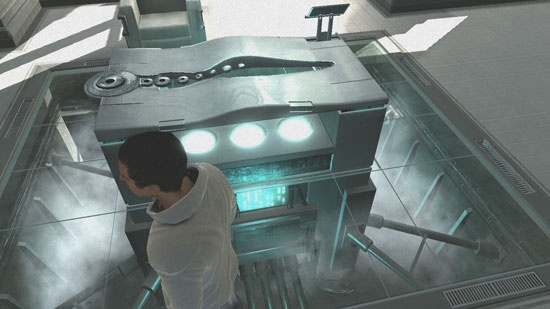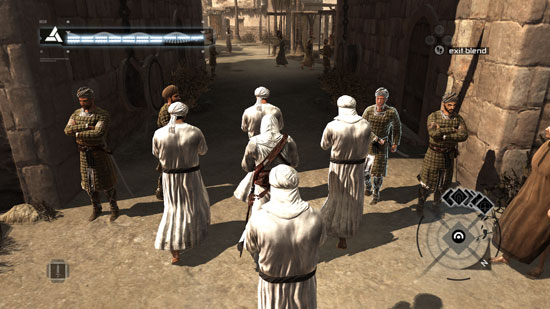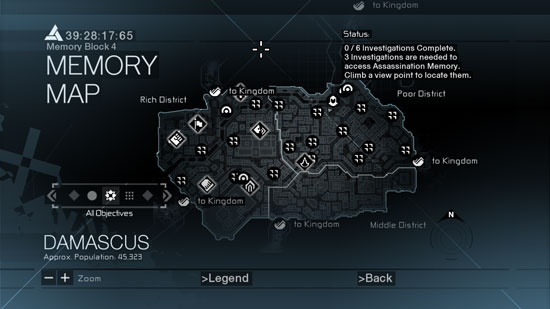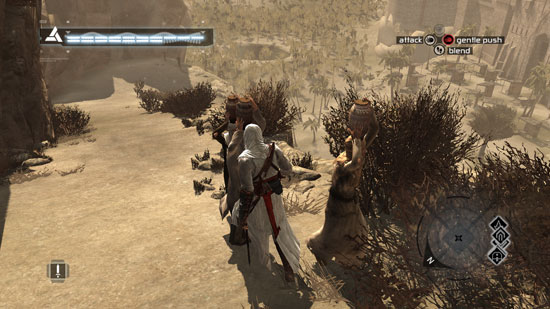Basic Plot and Gameplay
I suppose I should preface this section with a disclaimer that there will be some minor plot spoilers on this page. However, I emphasize the fact that these are minor spoilers -- most of this information is readily visible if you visit the Assassin's Creed website, and you will certainly discover within the first 10 minutes of playing the game the major "spoiler" I'm about to discuss. If you want to be completely surprised, however, feel free to skip the next several paragraphs.
The majority of Assassin's Creed takes place around 1200 A.D. -- 1191 A.D. to be precise -- but your actual character is merely reliving memories of an ancestor using future technology, a device called the Animus. So there are actually two characters, Desmond Miles from 2012 A.D. and Altaïr from the time of the Crusades. Both, incidentally, are assassins, though you will spend the vast majority of the game in Altaïr's shoes. The short summary is that some people are looking for information from Altaïr, information that is part of Desmond's "genetic memory".
 |
There's something of a Matrix vibe to the plot, but without all the machines taking over the world business. The futuristic pseudoscience seems to be at least partly a gameplay mechanic as it keeps you from dying and reloading; instead, you "lose sync" with your ancestor's memory and return to the last "sync point". "A checkpoint save system by any other name would smell as sweet…." Over time, as Desmond and Altaïr become more in sync with each other, Desmond recovers additional memories, improves "health", and improves in his abilities.
This is a gross oversimplification of the plot, so if the above summary makes you think that the game isn't something worth trying, let us state that we did find the game quite enjoyable and the storyline was compelling. It's not something likely to win any Academy Awards -- although a movie based off the story is apparently in the works -- but it does keep you playing to find out what happens next. By the end of the game we were a little disappointed that there wasn't more of a conclusion; Assassin's Creed 2 looks to be inevitable. In fact, this is supposed to be the first entry in a trilogy of games.
Gameplay (no more spoilers)
Given the title and setting, it should come as no surprise that the game involves killing... lots of killing. Throughout the game, you are given assassination targets -- men who through their actions are causing problems and need to be disposed of. However, you can't just jump straight to the major assassination target; first you have to scout out the area, gain information about the target's movements and whereabouts, and "plan" when and where to perform the assassination.
 |
The first assassination mission is likely to impress you with the environment and gameplay. Crowds of people move throughout the city, and you can use them to blend in and escape notice. You can run across the rooftops, leaping from building to building and grabbing onto ledges, and you can climb up to higher viewpoints to get a good look at your surroundings (and reveal nearby missions). Missions consist of information gathering as well as helping out citizens who are being harassed by corrupt guards. The first few hours of the game were extremely entertaining, and you can really get into playing the role of a stealthy assassin.
After a while, flaws in the gameplay start to become more apparent. The basic pattern listed above repeats itself throughout the game: show up in a new area, do a bit of scouting, perform a few side quests, and then take out your target. Afterwards, you need to escape from the city guards and make your way back to the Assassins' Bureau. Your sword fighting skills and other abilities increase over time, and you gain access to a few additional weapons. To counteract that, guards also become more adept. However, there's no getting around the fact that the gameplay eventually becomes extremely repetitive. This is probably the biggest complaint about the game, and it's a valid point, but it's compounded by other flaws.
 |
First impressions are that you are part of a living, breathing, teeming world -- not unlike the world found in Elder Scrolls: Oblivion. Citizens wander the streets, you can overhear vendors hawking their wares and other townsfolk engaging in gossip, and soldiers patrol the streets keeping order. Unlike Oblivion, however, all of the activity you see is merely a façade. The reality is that all the people are in scripted loops, endlessly repeating their activities. Stand in one place long enough, and you'll watch the same group of five women carrying jars on their heads walk by again and again, the same guards on patrol, etc. There are no day and night cycles -- everything takes place during the day -- which seems a little odd for an assassin game.
 |
Furthermore, when it comes right down to it, Altaïr is virtually invincible by any competent player. Guards attack one at a time, politely taking turns as you dispatch them, so combat quickly becomes a routine affair of blocking and counterattacking. In that sense, AC is nothing like the Thief games where Garrett was highly vulnerable and dependent largely on stealth in order to survive. You can play AC in a stealthy fashion if you want to, but there's little to keep you from sprinting through town to get from place to place as quickly as possible. The only requirement is that you have to rid yourself of any pursuit before you can start/complete any of the missions (and certain missions do require you to maintain anonymity).
















32 Comments
View All Comments
bill3 - Monday, June 2, 2008 - link
Actually it's terrible, I cant read the graphs AT ALL.seriously my eyes just glazed over those terrible charts..completely unreadable. I still, have no idea what I'm looking at. Is ATI supposed to be faster in this game? Why did they test with version 1.00 on ATI and 1.2 on Nvidia? I dont know because the graphs are totally useless.
Nihility - Monday, June 2, 2008 - link
I second that. The graphs are terrible. Maybe bar graphs would have been better?Sometimes when you're the one making the graph it's hard to imagine what other people are seeing when they look at them. I suggest having another pair of eyes check the graphs out for readability.
Besides that, I loved the review. Especially the performance part and the 10.1 controversy.
JarredWalton - Tuesday, June 3, 2008 - link
Charts are colored with similar colors used either for ATI vs. NVIDIA, 1.00 vs. 1.02, or dual-GPU vs. single-GPU. I could have generated four times as many graphs to show the same data, but I figure most people are capable of reading the labels on a chart and figuring out what they mean. Here's a hint: when you can't see the difference between two lines because they overlap, it's a tie.If you want to give specific examples and recommendations on what would look better and still convey the same amount of information, I'm all ears. However, simply stating that "the graphs are terrible" does little to help. Tell me what graph specifically is terrible, and tell me why it's terrible.
As an example of why I used these graphs, page 9 has two charts showing 40 total data points. You can get a clear idea of how performance scales with single or dual GPUs at the various detail settings looking at a single chart. Green is NVIDIA, Red is ATI. That makes a lot of sense to me. Creating ten different bar charts with four lines in each to show the same data makes it more difficult to compare how Medium graphics compares to High graphics performance, and it takes up five times as much space to tell the same "story".
Page 6 is the same thing, but with green used for dual-GPUs (light and dark for 1.00 and 1.02) and red for single GPUs. 24 data points in two charts instead of using six charts. Having established that 1.00 doesn't perform any different than 1.02 on NVIDIA hardware, I skipped the 1.00 NVIDIA numbers to make those charts easier to read on page 7. Then I put in the four standard test system (0xAA and 4xAA, ATI and NVIDIA) on 1.02, with 1.00 4xAA ATI in blue as a reference.
Lastly, on page 8 I have two clock speeds on NVIDIA, three on ATI, with different base colors for single and dual GPUs. ATI and NVIDIA are in separate charts, and brighter colors are for a higher overclock.
There's method to my graphing madness. Are the charts immediately clear to a casual glance? No, but then that's really difficult to do while still conveying all of the information. I spent a lot of time trying to make comprehensible charts, and settled on these as the best option I could come up with. Again, if they're so bad, it must be easy to generate something clearly better - have at it, and I'll be happy to use any sensible suggestions. However, if the only complaint is that you actually have to look at the charts and think for a minute before you understand, I'm not likely to be very sympathetic. I think our readers are smart enough to digest these graphs.
mpjesse - Monday, June 2, 2008 - link
While I appreciate the detailed review, isn't it a little irrelevant now? I mean, the game's been out for nearly 2 months now and it's been reviewed everywhere. The only thing new about this review are the performance benchmarks, in which case I would have have made the review solely about performance instead of gameplay.Just my 2 cents.
ImmortalZ - Monday, June 2, 2008 - link
Its sad that the companies with money always manage to suppress innovation.I hope this article by AT will raise some ruckus in the collective Interwebs and cause something. But I doubt it.
ViRGE - Monday, June 2, 2008 - link
For what it's worth, another forum I read had some screenshots comparing DX10 and DX10.1. The problems the poster had managed to find involved trees; there was some kind of post-processing rendering going on with trees that wasn't occurring with DX10.1, which made them look weird.Not fixing 10.1 may be an NVIDIA thing, but there was definitely a problem with it as-is.
tuteja1986 - Monday, June 2, 2008 - link
Well why where the hell is nvidia dx10.1 support if dx10.1 actually brings some kind of performance improvement in AA.Why aren't GT200 series have DX10.1 ?
I thought PC gaming was all about being the cutting edge on all technology front...
Anyways , this is not the 1st time Ubisoft or Nvidia have done this.
wyemarn - Monday, June 2, 2008 - link
Maybe because Nvidia GPUs cant support AA through shaders. So no use supporting dx 10.1. ATI GPUs have 320 stream processors so it can utilize for shaders and etc. Nvidia cards have less SPs but more ROPs, TMUs which translates to more brute power if games dont use shaders or SPs much. Technology wise, I think ATI is ahead but NVIDIA GPUs have game developer support and more raw horsepower so performance wise NVIDIA is ahead and I think this trend will continue with GTX200 series. I choosed G92 over RV670 because the raw performance is much better even though on paper HD 3800 series look great.SteelSix - Monday, June 2, 2008 - link
Worthy of a thread in Video. I just started one..Gannon - Monday, June 2, 2008 - link
The original halo had performance issues but they weren't alarming, halo was actually not too bad port compared to many other console to PC disasters. Halo 1 got 'better with hardware' advancing. Halo 2 on the other hand is just all around atrocious. Halo 2 was just not a very well made game, period, despite the addition of cutscenes, etc. Halo 1 had a much better feel and better vehicle design IMHO, I hated how the warthog looked in Halo 2, it annoyed me to no end.